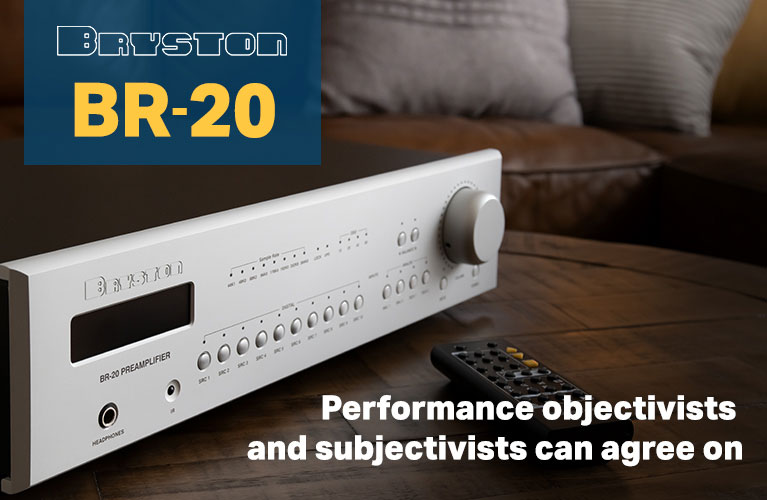Note: Measurements taken in the anechoic chamber at Canada's National Research Council can be found through this link.

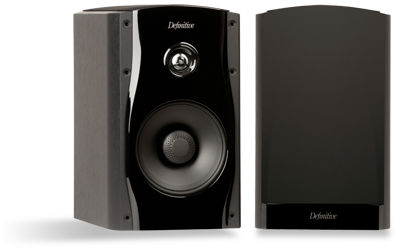 The past couple of years have seen a stream of very high-quality bookshelf speakers pass through my listening room. Ranging in cost from $2000 to $4000 USD per pair, these minimonitors all performed extremely well, clustering near the top of the price-performance curve. While each had a unique aural signature that meant it would appeal to some tastes and not others, each model also exhibited characteristics that placed it firmly among the best in its price class.
The past couple of years have seen a stream of very high-quality bookshelf speakers pass through my listening room. Ranging in cost from $2000 to $4000 USD per pair, these minimonitors all performed extremely well, clustering near the top of the price-performance curve. While each had a unique aural signature that meant it would appeal to some tastes and not others, each model also exhibited characteristics that placed it firmly among the best in its price class.
But while it’s a lot of fun to review an expensive model from a venerable manufacturer that knows a thing or two about designing and building speakers, it’s more difficult to get excited about such products. I expect a certain level of performance from a speaker costing $2000 to $4000/pair -- a bias that comes from hearing many great-sounding but costly bookshelf models. At those prices, designers can afford to use the best drivers, the highest-quality crossovers, the most rigid cabinets -- so one could argue that the deck is stacked in their favor.
The greater challenge is to design and build a speaker that approaches the performance of the best but costs a fraction of their price. Inevitably, hard choices must be made about how best to maximize performance and keep costs down while producing something attractive enough that people will want to display it in their homes. Although such speakers might not have drivers made of exotic materials or a Ferrari paint job, it’s far more exciting to hear how much they can do for so little cost.
Which was why I was eager to hear the new StudioMonitor 55, from American manufacturer Definitive Technology.
Description
The latest edition of the StudioMonitor series from Definitive Technology comprises three shelf/stand-mount models. In order of increasing size and price per pair, they are: the StudioMonitor 45 ($398), the StudioMonitor 55 ($598), and the StudioMonitor 65 ($898).
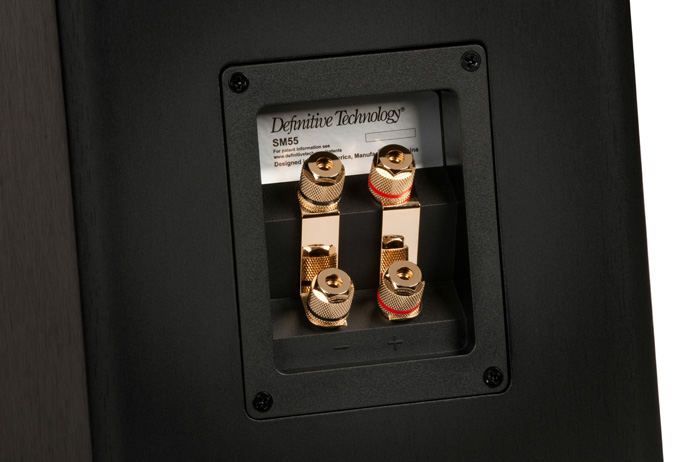
The SM55 measures 13"H x 7 7/8"W x 12 3/8"D and weighs 15.5 pounds. Two sets of five-way binding posts on the rear panel accept spades, banana plugs, or bare wire, and allow for biwiring or biamping. The cabinets are made of MDF, with interior bracing to minimize resonances. Finished in a wood-grain, matte-black vinyl veneer with a high-gloss black baffle and trim, the SM55 looks sharp in a handsome but understated way. The baffle is designed to reduce diffraction, and the high-gloss finish adds stylish flair to a speaker that otherwise calls little attention to itself. I found the SM55s very easy to live with; I can imagine them being suited to many different décors.
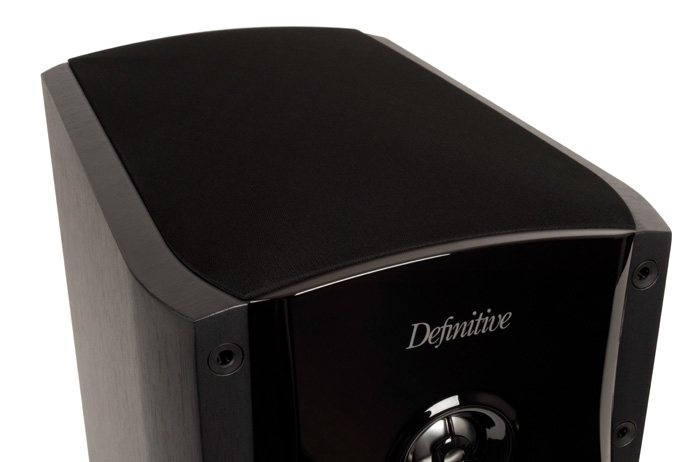
Looked at head on, the SM55 seems a conventional two-way design, but closer inspection reveals that the top of the cabinet is a svelte cloth grille concealing what Definitive Technology calls a "bass radiator," more commonly known as a passive radiator. Incorporating a bass radiator into a speaker is nothing new for DefTech -- many of their past bookshelf models have included them -- but most of their competitors don’t do this.
Much like a port, a passive bass radiator helps extend and amplify a speaker’s low-end response by taking advantage of the movement of the active midrange-woofer. The motion of the active driver is directly coupled to the radiator, causing it to resonate at the same frequency. As a result, the total combined radiating surface of the SM55’s 6" x 10" bass radiator and 6.5" midrange-woofer is greater than that of a single 10" woofer -- an impressive feat for a midsize bookshelf model.
That 6.5" midrange-woofer has a die-cast aluminum basket and employs a second-generation version of DefTech’s Balanced Double Surround System (BDSS), first used in their Bipolar series. BDSS surrounds are intended to improve a driver’s mechanical stability by supporting the speaker cone at both its inner and outer edges, allowing for longer, more linear excursion, and better driver damping to help reduce cone resonances. The cone itself is made of a mineral-filled polymer that is both lightweight and rigid.
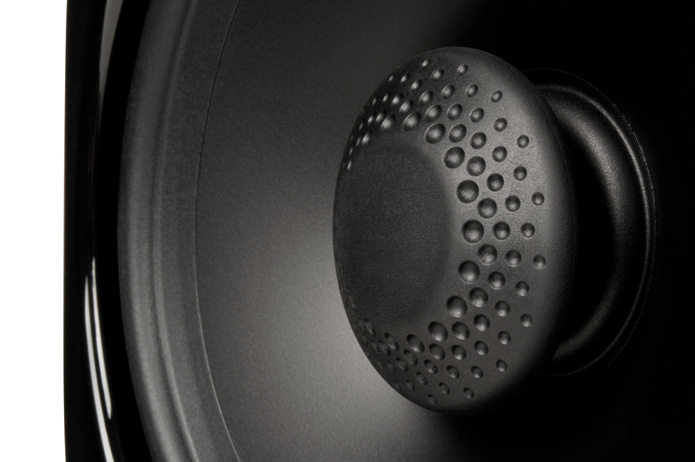
Looking at the midrange-woofer straight on, you see, emerging from the center of the cone, a black, mushroom-shaped waveguide with a dimpled surface. This is unique; I was fortunate that Tim Gladwin, who designed the SM55’s drivers, paid me a visit to answer some questions. He explained that the cavity at the center of the driver is resonant, and that simply sticking a broom handle in there can easily dissipate the energy produced by the cone’s movement. Since a broomstick isn’t exactly a practical solution, Gladwin designed the mushroom-like waveguide to eliminate the resonance while simultaneously improving the driver’s off-axis response and producing broad, even dispersion; in short, he found a single solution to two different problems.
Like its midrange-woofer, the SM55’s 1" dome tweeter of pure aluminum is a second-generation version of the one used in the Bipolar series. It sits in a shallow waveguide formed by the glossy front baffle, a technique increasingly used by DefTech and others to help control a driver’s dispersion while increasing its efficiency. Although Gladwin and his team in Pakenham, Ontario, do all of the acoustics work for DefTech, the drivers are built by a third party to their specifications.
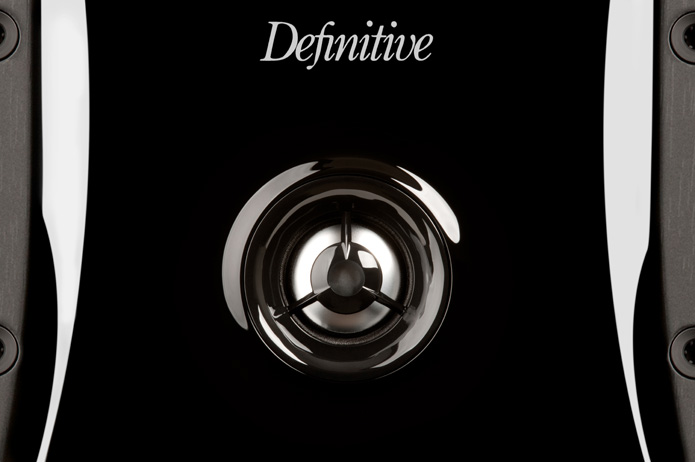
Gladwin takes his measurements using diagnostic equipment designed by German acoustical engineer Dr. Wolfgang Klippel. However, Gladwin made it very clear that, despite all the evaluative tools at his disposal, he most values actually listening to his drivers. Borrowing a line from Dr. Floyd Toole, the well-known acoustics expert who set up the sound lab at Canada’s National Research Council, Gladwin pointed out that a computer and a microphone are no substitute for two ears and a brain.
Definitive Technology claims that the SM55’s frequency response is 32Hz-30kHz -- a ridiculously wide bandwidth for a bookshelf speaker of modest size. The impedance is listed as 8 ohms, the sensitivity as 90dB/W/m, and the recommended amplification as 20-225W. You can of course use a beefier amplifier to drive the SM55s, but they’re such an easy load that you don’t need all that much power to get them singing. Even a solid 50W should be sufficient for most listening needs.
Setup
I set the SM55s atop 24"-tall Osiris stands and drove them with a Bryston B100 SST integrated amplifier, to which they were connected with AudioQuest Type 4 speaker cables terminated in banana plugs. An NAD C542 CD player was used as a transport, its digital signal sent to the Bryston’s onboard DAC through an AMX Optimum AVC31 coaxial cable. I used a Thorens TD-160HD turntable with Rega RB250 tonearm and Dynavector DV-10X5 high-output moving-coil cartridge to play LPs, and wirelessly streamed music from my Apple iMac computer through an Apple AirPort Extreme to an Apple AirPort Express. An XtremeMac XtremeHD TosLink cable connected the Express to the Bryston’s DAC. Everything was plugged into an ExactPower EP15A power-line conditioner-regenerator.
I experimented with the positioning of the SM55s, but generally kept them in the same locations that I use for my reference speakers: with their front baffles 42" from the front wall and 6’ from the listening chair, and their tweeters 72" apart. They were toed in slightly so that the tweeters’ axes crossed just behind my head. In this spot, the SM55s filled the room with wall-to-wall sound while producing excellent center fill and more than enough bass. And speaking of bass . . .
Definitive performance
The StudioMonitor 55 is a floorstanding speaker masquerading as a bookshelf speaker. The pair of them produced deeper, more voluminous bass than any similarly sized speaker I’ve heard. That bass radiator was obviously contributing to the SM55’s low-end output, but whatever the reason, the result was a speaker that played deeper, and with more authority, than its size and price had led me to expect. The beats in "Youlogy," from Shabazz Palaces’ Black Up (CD, Sub Pop 98787 09002), were visceral through the SM55s -- even at offensively high volumes, these little dynamos had no problem keeping up with the demands of this hard-hitting hip-hop track. The SM55s will likely provide all the bass many listeners will ever need, regardless of what type of music they enjoy. Unless you need your room to rumble, a subwoofer should be optional.
What really impressed me wasn’t just that the SM55 generated a lot of energy down low, but that that energy managed to balance weight with nimbleness, starting and stopping quickly, conveying detail in the low frequencies that fatter-sounding speakers tend to gloss over. This resulted in a more articulate sound, as I heard while listening to "Caught a Lite Sneeze," from Tori Amos’s Boys for Pele (CD, Atlantic 82862-2). This track is fairly explosive, and the SM55s responded by reproducing its dynamic shifts with ease while always remaining clean and composed. The song centers on Amos’s voice, here mixed larger than life and supported by a powerfully percussive backbone that was unable to trip up the DefTechs, even at volumes that bordered on the uncomfortably loud. The beat of the drums was powerful yet poised through the SM55s, propelling the track forward with outstanding vitality and control. It was obvious that the SM55s not only sounded good with a lot of power pumped through them, they thrived on it.
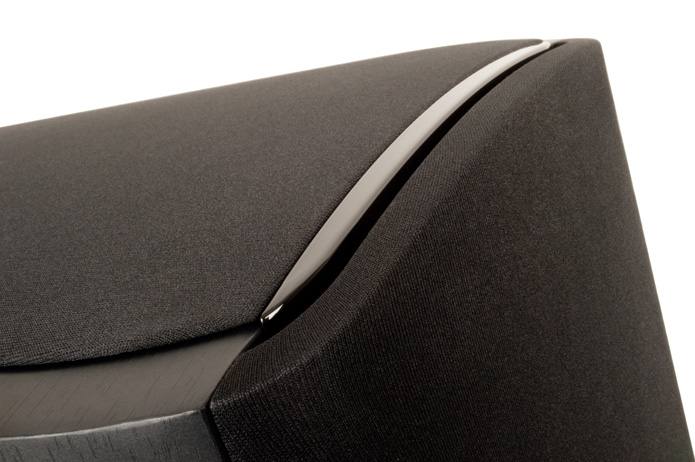
In Amos’s "Way Down," from the same disc, the voice of one baritone is clearly audible at the rear of the gospel choir. As the track ends, the drone of his voice trails off into the darkness of an ink-black background. This ability to clearly resolve spatial cues and low-level details was another of the SM55’s strengths, bringing it closer in overall performance to some of the reference bookshelf speakers I’ve reviewed in the past two years. Minimonitors are often associated with good imaging, and the SM55s excelled at it.
With "Reckoner," from Radiohead’s In Rainbows (LP, TBD Records TBD0001), the SM55s created a stage as wide as my room, the tambourine and cymbal extending beyond the outer edges of the left and right speakers. Thom Yorke’s voice is a bit murky in this track, and mixed to appear at the center of the stage, behind the plane of the speakers. The DefTechs did a fine job delineating its sonic outlines, making it very easy to sort out what was happening in front of me.
In addition to their outstanding bass performance and imaging, the SM55s’ reproduction of the midrange was clean and open, allowing me to more easily hear the distinct characters of voices and instruments. In "Peeping Tomboy," from Kurt Vile’s Smoke Ring for my Halo (LP, Matador OLE938), the guitar sounded clear and detailed as the notes sprang from its strings. The sound was warm yet incisive, and very musical through the SM55. This was due in part to the fact that I was listening to an LP, but the important point here is that the SM55 did what good a speaker should: It got out of the way and let the music speak for itself, good or bad.
The SM55 was well extended at the top of the audioband, reproducing the highest frequencies with incisiveness and intelligibility. In "So What," from Miles Davis’s Kind of Blue (CD, Columbia/Legacy CK 64935), the shiny tone of John Coltrane’s tenor saxophone was mesmerizing, sounding as clear and precise as the rest of the band. The SM55 didn’t roll off the highs, nor did it sound bright or call undue attention to itself. Its tweeter blended seamlessly with its 6.5" midrange-woofer to produce coherent musical pictures.
Comparison
I compared the Definitive Technology StudioMonitor 55s with my own speakers, Amphion’s Argon3L floorstanders. At $3995/pair in a real-wood veneer, the Argon3L costs nearly seven times the SM55’s price, and listening to them side by side proved interesting.
Like the DefTech, the Amphion is a two-way design with a 6.5" midrange-woofer and a 1" metal-dome tweeter. The Argon3L’s tweeter, however, is placed at the mouth of a much deeper waveguide, and it lacks a bass radiator; instead, a rear-firing port augments the speaker’s low-end output.
The American and Finnish speakers had one thing in common: both produced lots of clean, strong bass. The Argon3L is a smallish floorstander; if you’ve never heard but only seen pictures of it, you might be inclined to think it lacks weight down low. It doesn’t -- and the SM55’s appearance is just as deceptive. You don’t typically expect a bookshelf speaker -- especially one costing $598/pair -- to dig so deep, but this is another area in which the SM55 exceeded expectations.
It was incredible how the diminutive SM55s’ 6.5" drivers and bass radiators managed to extract remarkably full, voluminous low end from the Shabazz Palaces’ "Youlogy." They weren’t able to match the sheer output of the Amphions, which sound fatter and even fuller, but it would have been shocking had it been otherwise, given the enormous disparities in size and price. What surprised me was that, in terms of bass output, the SM55 was able to seriously compete with the Argon3L, offering a sizable amount of the latter’s performance for a fraction of the price.
The SM55 provided wonderfully detailed and lucid reproductions of well-recorded music, but couldn’t quite match the transparency of the Argon3L. The various acoustic strings in "Louis Collins," from Jerry Garcia and David Grisman’s Shady Grove (CD, Acoustic Disc ACD-21), had a little more pop and sounded a touch purer through the Amphion, the notes jumping off the strings with a bit more zing, which helped bring this bluegrass ballad more to life. The SM55 sounded clean, the Argon3L squeaky clean -- but the difference wasn’t huge.
Overall, even though the DefTechs didn’t equal the performance of the Amphions, the minimonitors didn’t lag as far behind the floorstanders as you might imagine. As I listened to the SM55s, I didn’t find myself thinking too much about the Argon3Ls sitting idle in the next room; rather, I found myself enjoying a pair of great-sounding, absurdly affordable speakers that fit my sonic tastes extremely well. The StudioMonitor 55 sounded like a much more expensive loudspeaker.
Conclusions
If you like solid bass, clear-cut imaging, and a clean, open midrange, but don’t have the room and/or the money for bigger speakers, Definitive Technology’s StudioMonitor 55 could be what you’ve been waiting for. It does many things well for the audiophile on a budget, and doesn’t take a back seat to speakers costing even multiples of its price. The result of years of research and development from a company that has designed and built loudspeakers for over two decades, the SM55 would sell for considerably more if it came out of the workshop of a small, boutique manufacturer. In the category of nearly full-range loudspeakers costing less than $1000/pair, the StudioMonitor 55 makes a strong case as the model to beat. Highly recommended.
. . . Philip Beaudette
philipb@soundstagenetwork.com
Associated Equipment
- Speakers -- Amphion Argon3L
- Integrated amplifier -- Bryston B100 SST
- Sources -- NAD C542 CD player; Thorens TD-160HD turntable, Rega RB250 tonearm, Dynavector DV-10X5 high-output moving-coil cartridge; Apple iMac computer, Apple AirPort Extreme, Apple AirPort Express
- Speaker cables -- AudioQuest Type 4
- Interconnects -- AudioQuest Copperhead, AMX Optimum AVC 31 coaxial, XtremeMac XtremeHD TosLink
- Power conditioner -- ExactPower EP15A
Definitive Technology StudioMonitor 55 Loudspeakers
Price: $598 USD per pair.
Warranty: Five years parts and labor.
Definitive Technology
11433 Cronridge Drive, Suite K
Owings Mills, MD 21117-2294
Phone: (800) 228-7148, (410) 363-7148
Fax: (410) 363-9998
E-mail: info@definitivetech.com
Website: www.definitivetech.com






















